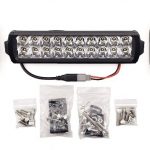For folks looking to start u a garden or increase the size of their current garden, there are a few ways of going about it. If you only want a tiny garden or a minor expansion, chances are you can do it with some picks and shovels. But if you want a large garden, or you want to increase the size of your existing garden greatly, you might want to consider a lawn tiller.
Push Tiller or Pull Tiller?
There are only two types of tiller when it comes to propulsion – either you push them in front of you while you’re on foot, or you can pull them along behind a lawn tractor, ATV, or other utility vehicle. The ones you pull behind are generally only useful for large plots, and only if you plan on using them often – clocking in at $1,500 or more each, they are not at all worth it for the hobby gardener or even a consistent gardener who only maintains a small patch. They can chew u a lot of ground, especially with their width that can strip up three to four feet of ground at once.
Front-Tine or Rear-Tine
If you feel that a pull-behind tiller is a bit too much for what you need, you’ve then got to decide if you want a front-tine or rear-tine tiller.
Rear-tine tillers are the heavy-duty workhorses of the bunch, powered by a larger gas-powered engine that usually hangs in front of the wheels in order to provide balance. The engine powers the wheels as well as the tines, and many of these units come with a number of controls to set the speed of the unit, the tines, depth, and more. They can cover more ground than a front-tine tiller, as the larger engine can power a wider tine set. A complex unit means a high price – a really good rear-tine tiller can most just as much as a pull-behind tiller.
The average hobby gardener generally will be best suited by the front-tine tillers on the market. These have the tines positioned in front of the engine, and the wheels are simply for ease of movement, they are not powered via the engine. This allows for the unit to have a smaller engine, which means the price can be lower – running in the $400 range, they are good investments for gardeners maintaining decent-sized patches.
Mini Tiller
If even the full-size front- or rear-tine tillers are a bit too much for the size of the garden you’re looking at, drop down to a mini tiller. These are good for hobby gardeners – anyone planting a garden much bigger than 25 square feet or so might want something larger. Likewise, they are also not all that great in hard, compacted soil. Mini tillers are lightweight, thin, and with blades that spin forward to help propel the tiller along. This all makes it hard to drive a mini tiller into the surface hard enough to get it to dig in. Mini tillers are the least expensive of the bunch, easiest to store, and most versatile.
Choosing the right tiller can make maintaining your garden year-in and year-out a much easier proposition, and it won’t necessarily break the bank wile you break the ground. So stow the hoe, pick, and shovel, and see about making it a little easier on your back.






